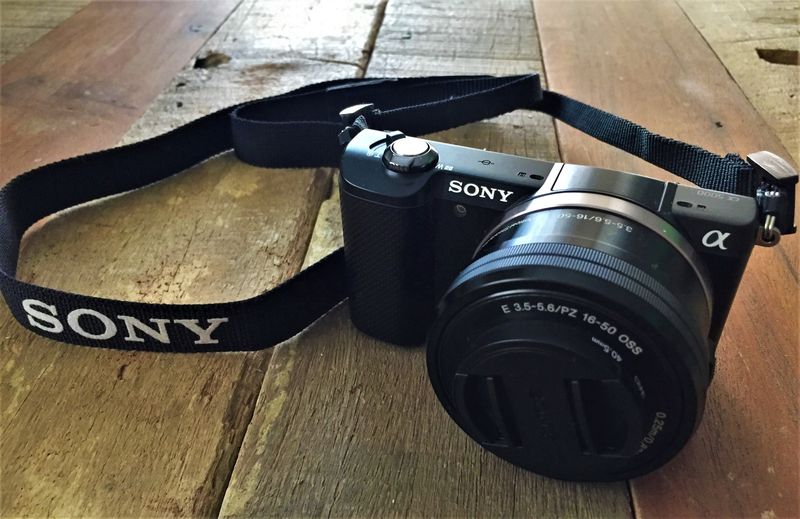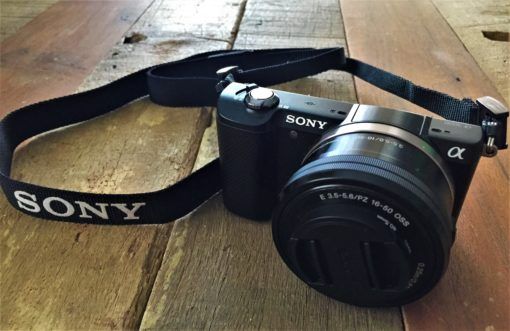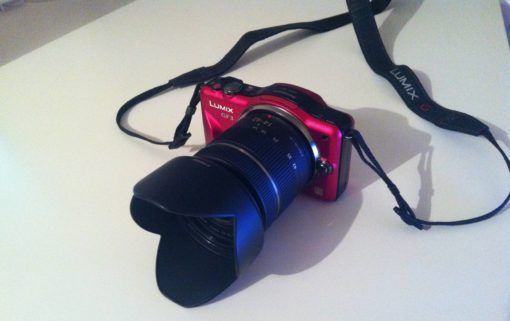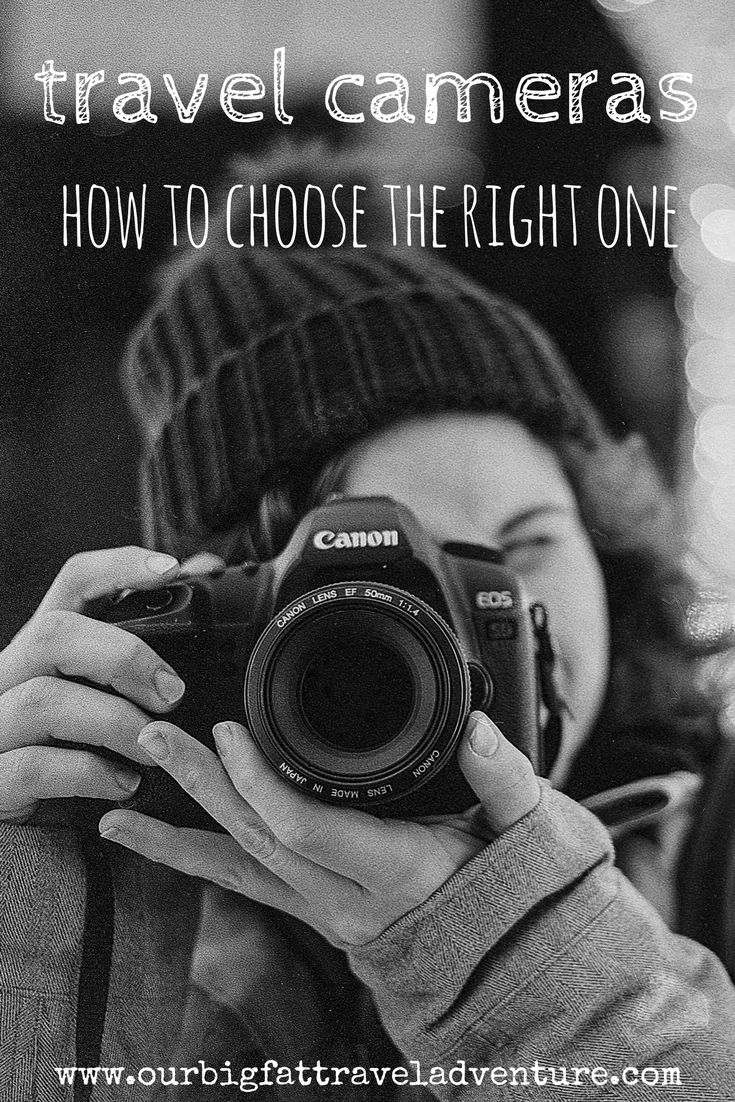
21 Sep Travel Cameras – How to Choose the Right One
Choosing the best adventure travel camera for our trip was a big decision. Not only is a camera one of our more expensive pieces of travel gear, it’s also one of our most important as it’ll help us to capture memories of all the places we go and people we meet. So, what are the best travel cameras?

2018 travel camera update
Our Lumix GF3 camera (see below) worked brilliantly and lasted almost five years of travel. However, the lens got burnt at a festival in Spain so we decided to replace it with a newer model. We went to the London Camera Exchange in the UK and asked the sales assistant for a mirrorless, lightweight, compact system camera. She recommended the Sony A5000, which has a flip screen which is great for selfies and vlogging.

Our 2018 travel camera, the Sony A5000
If you’re looking for a Sony compact camera, this one’s great. It also has the same size sensor as a DSLR, yet the camera is as small as a micro four-thirds and you can buy other lenses to go with it. We paid £300 for the Sony Alpha 5000 and bought a lens protector to avoid scratches to our new camera for £15, I’d highly recommend doing the same.
Which camera should I buy?
Neither of us know that much about the best travel cameras. Aside from borrowing a Cannon DSLR camera from university for my course work, we’ve only really had experience in using simple point and shoot cameras. As you can probably tell by now, we also don’t have particularly good photography skills. Nevertheless, we know that taking photographs will be a big part in cataloguing our journey and so we’re keen to choose the best travel camera we can and hopefully, somewhere along the line, learn to use it reasonably well.
How to choose a camera? Well, with some difficulty it turns out. There were two main options:
- A fancy DSLR – these are a favourite of many travel bloggers. We found that the most basic DSLR camera would cost us at least £300, but we had no idea whether we’d actually use all the settings or make the most of one. Another issue for me was the size and value of a camera like this, even though it may be the best camera for travel photography. I feel like a big DSLR would not only be a target, but would literally be a bit of a pain in the neck to lug around all the time.
- A basic digital point and shoot camera – on the other hand, we could get a decent digital camera which would only cost around £150 to £200 and would arguably still take pretty good shots. The plus points of going for this option are that the camera’s more inconspicuous and easier to carry around, especially on day trips, as it’s a lightweight camera.
Travel Cameras – so which one did we choose (our 2013 model)?
The travel camera we finally went for was something in between the two. So, what is the best travel camera? After doing some research, Andrew happened to come across the Panasonic Lumix GF3 (with a 14 to 42mm lens) – which appears to be the best camera for travelling (in our opinion) for the following reasons:

- It’s smaller than a DSLR so will take up less space and won’t be as conspicuous
- As with a DSLR, you can buy different lenses for it, unlike a point and shoot
- The quality of the lens that comes with the camera is better than the lens of any point and shoot we’ve had
- It has fewer technical features than a DSLR, which is good because we probably wouldn’t use all the ones on a better camera anyway
- However, it has more features than a basic point and shoot, so gives us the potential to take better pictures
- As with any camera these days, it lets you record video
- It’s a lot cheaper than a DSLR and many high-end point and shoot cameras as we got a deal from Camera World in London: the camera and lens only cost £200 thanks to a Panasonic promotion.
The only downside is that we couldn’t get the black version of the camera, so instead we have the red, which admittedly does look pretty, but it also detracts from our aim of choosing something that doesn’t stick out.
Camera insurance travel
It’s essential to get travel camera insurance. We use Photoguard (a UK company), which we update annually for around £80. This covers theft and accidental damage with a £50 excess and is a good option for protecting travel cameras. The policy also covers our Macbook and Acer laptop, you just have to be prove that you use your laptops to store and edit photos. We always take out general travel insurance too, you can read about how we find the best travel insurance in this post, or check out World Nomads, a popular option for long-term travellers.

Pin Me!
So, what do you think is the best digital camera for travel?
*There are affiliate links in this post and we will receive a small commission if you buy any travel products through these links.





Tony (@ 20 Years Hence)
Posted at 14:19h, 27 SeptemberI’ve had a GF-1 ever since it came out, and have loved the camera more than almost any other I have owned. Personally, I find the newer GF series to be a little stripped down, the GF-1 was the only GF that was really an “enthusiast” level camera, but for someone who wants nice pictures without worrying about the camera getting in the way, the GF-3 is a great choice. For anyone who is super budget conscious I would recommend finding a refurbished or used GF-1 and buying a lens (or three) separately. Used GF-1s can be had for peanuts, and they have the same sensor and identical image quality as the newer models. Of course, now there is the GX-1, but it’s more expensive (and also better). I was going to just bring the GF-1 on our trip, but Olympus decided they needed my money and released the OM-D, which I personally think is the best travel camera ever made (assuming money IS an object, which it is for us). It’s certainly expensive, but nothing else comes close for the same price.
I think you’ll be glad you went with this system, it’s small, has great image quality and new lenses are added all the time. I have been nothing but pleased with it. If you get the chance (and the money is right), do yourselves a favor and buy the Panasonic 20mm f1.7 lens, it’s fantastic and a must-have for mirrorless camera owners. I still use it more than almost any lens other than my Olympus 45mm f 1.8, which is also spectacular.
Feel free to hit me up any time you want to talk mirrorless or want some photo tips! Have fun with the camera!
Amy
Posted at 15:44h, 27 SeptemberWow, you really know your cameras Tony – we’ll definitely come to you for more camera-related advice! Wish we’d looked into a second-hand GF-1 now, although buying more lenses is still an option, so thanks for the tip about which to choose. The photos you guys have taken so far on your trip look great by the way – we’re looking forward to seeing more!
Vicky from acoupletravelers
Posted at 14:32h, 23 OctoberThis camera looks like a great in between. I brought my DSLR, mainly because I just purchased it in 2010 and couldn’t justify leaving it behind and buying a whole new camera, but it definitely is a pain to carry around.
Amy
Posted at 15:04h, 23 OctoberThat’s exactly what we thought Vicky, we weren’t keen on lugging around a larger and more expensive gadget than we need to. Hope our Lumix does ok when we’re on the road!